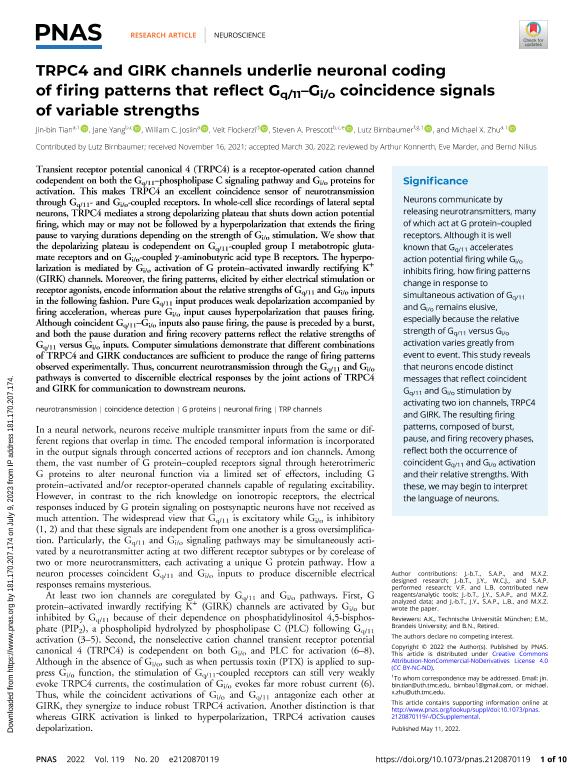Mostrar el registro sencillo del ítem
dc.contributor.author
Tian, Jin Bin
dc.contributor.author
Yang, Jane
dc.contributor.author
Joslin, William C.
dc.contributor.author
Flockerzi, Veit
dc.contributor.author
Prescott, Steven A.
dc.contributor.author
Birnbaumer, Lutz

dc.contributor.author
Zhu, Michael X.
dc.date.available
2023-11-01T11:03:52Z
dc.date.issued
2022-05
dc.identifier.citation
Tian, Jin Bin; Yang, Jane; Joslin, William C.; Flockerzi, Veit; Prescott, Steven A.; et al.; TRPC4 and GIRK channels underlie neuronal coding of firing patterns that reflect Gq/11-Gi/o coincidence signals of variable strengths; National Academy of Sciences; Proceedings of the National Academy of Sciences of The United States of America; 119; 20; 5-2022; 1-10
dc.identifier.issn
0027-8424
dc.identifier.uri
http://hdl.handle.net/11336/216722
dc.description.abstract
Transient receptor potential canonical 4 (TRPC4) is a receptor-operated cation channel codependent on both the Gq/11-phospholipase C signaling pathway and Gi/o proteins for activation. This makes TRPC4 an excellent coincidence sensor of neurotransmission through Gq/11- and Gi/o-coupled receptors. In whole-cell slice recordings of lateral septal neurons, TRPC4 mediates a strong depolarizing plateau that shuts down action potential firing, which may or may not be followed by a hyperpolarization that extends the firing pause to varying durations depending on the strength of Gi/o stimulation. We show that the depolarizing plateau is codependent on Gq/11-coupled group I metabotropic glutamate receptors and on Gi/o-coupled γ-aminobutyric acid type B receptors. The hyperpolarization is mediated by Gi/o activation of G protein-activated inwardly rectifying K+ (GIRK) channels. Moreover, the firing patterns, elicited by either electrical stimulation or receptor agonists, encode information about the relative strengths of Gq/11 and Gi/o inputs in the following fashion. Pure Gq/11 input produces weak depolarization accompanied by firing acceleration, whereas pure Gi/o input causes hyperpolarization that pauses firing. Although coincident Gq/11-Gi/o inputs also pause firing, the pause is preceded by a burst, and both the pause duration and firing recovery patterns reflect the relative strengths of Gq/11 versus Gi/o inputs. Computer simulations demonstrate that different combinations of TRPC4 and GIRK conductances are sufficient to produce the range of firing patterns observed experimentally. Thus, concurrent neurotransmission through the Gq/11 and Gi/o pathways is converted to discernible electrical responses by the joint actions of TRPC4 and GIRK for communication to downstream neurons.
dc.format
application/pdf
dc.language.iso
eng
dc.publisher
National Academy of Sciences

dc.rights
info:eu-repo/semantics/openAccess
dc.rights.uri
https://creativecommons.org/licenses/by-nc-sa/2.5/ar/
dc.subject
COINCIDENCE DETECTION
dc.subject
G PROTEINS
dc.subject
NEURONAL FIRING
dc.subject
NEUROTRANSMISSION
dc.subject
TRP CHANNELS
dc.subject.classification
Bioquímica y Biología Molecular

dc.subject.classification
Ciencias Biológicas

dc.subject.classification
CIENCIAS NATURALES Y EXACTAS

dc.title
TRPC4 and GIRK channels underlie neuronal coding of firing patterns that reflect Gq/11-Gi/o coincidence signals of variable strengths
dc.type
info:eu-repo/semantics/article
dc.type
info:ar-repo/semantics/artículo
dc.type
info:eu-repo/semantics/publishedVersion
dc.date.updated
2023-10-30T17:57:20Z
dc.journal.volume
119
dc.journal.number
20
dc.journal.pagination
1-10
dc.journal.pais
Estados Unidos

dc.description.fil
Fil: Tian, Jin Bin. University of Texas; Estados Unidos
dc.description.fil
Fil: Yang, Jane. University Of Toronto. Hospital For Sick Children; Canadá
dc.description.fil
Fil: Joslin, William C.. University of Texas; Estados Unidos
dc.description.fil
Fil: Flockerzi, Veit. Universitat Saarland; Alemania
dc.description.fil
Fil: Prescott, Steven A.. University Of Toronto. Hospital For Sick Children; Canadá
dc.description.fil
Fil: Birnbaumer, Lutz. Pontificia Universidad Católica Argentina "Santa María de los Buenos Aires". Instituto de Investigaciones Biomédicas. Consejo Nacional de Investigaciones Científicas y Técnicas. Oficina de Coordinación Administrativa Houssay. Instituto de Investigaciones Biomédicas; Argentina
dc.description.fil
Fil: Zhu, Michael X.. University of Texas; Estados Unidos
dc.journal.title
Proceedings of the National Academy of Sciences of The United States of America

dc.relation.alternativeid
info:eu-repo/semantics/altIdentifier/doi/http://dx.doi.org/10.1073/pnas.2120870119
Archivos asociados
